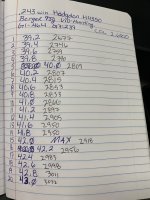^^^ Pretty much nailed it. Test-to-test variation on small sample size "tests" meets or exceeds the difference between loads you think you're seeing. In most cases unless you're changing over a grain of powder charge at a time, there is VERY marginal difference between powder ladder or seating depth ladder 20-30 or even 100 shot groups.
Beyond that, group size is a horrible metric. Regardless of if you shoot 2 or 100 shots, you're only measuring 2 of them. Even worse, there is no correlation back to the weapon system. No correlation to POA, nor bore axis, nor large sample MPOI... It's just the 2 shots with the biggest distance between them, ignoring the distribution of the others in the group. HOWEVER, using tools like mean radius and radial SD (which fairly accurately quantify the dispersion characteristics of a group) requires sample sizes that most people find austere. Data sets start telling the story around 20 shots, and become pretty "practically" repeatable around 30-35.
Some things I've learned from a few thousand rounds worth of 20-100 shot group data sets:
Bear in mind this is for producing ammo that can handle use. Enough neck tension I'd take it hunting, hiking, load in an AR, etc... You may see some slight performance benefit from ammo you have to BR-style baby handle, but in the practical realm, IMO, it's largely a waste of time/effort. In other words, that ammo probably wouldn't survive feeding out of a magazine.
-Brass prep beyond using same mfg/same lot is mostly a waste of time. I've taken virgin unsorted brass vs. once fired, volume sorted, neck turned annealed, mandrel died, neck ID honed, graphite necks, trimmed/deburred, deburred flash hole cases and the results were statistically identical... You can even do 20-25 virgin cases vs. the same case loaded 20-25 times (AMP + trim every firing) and the results are nearly identical. This isn't to say you or a brass mfg. can't fuck it up. If things are way out of whack you can see problems from brass, but within the realm of someone who has half a clue what they're doing it's largely a non-issue. My personal take on the subject is that the variation in chemical potential -> kinetic energy transfer, and the corresponding changes to the shape of the Pressure vs. time curve vastly out weigh whatever neck tension and volume variation exists at the start of the firing event (within reason, like I said you can fuck it up if you try). Once the bullet starts moving, the delta in volume is orders of magnitude larger than the volume difference case-to-case. YMMV.
- Powder type and lot# is the biggest influence on both dispersion and MV spreads
- Powder charge is the next biggest influence. With the exception of Varget, the trend in my testing has always been more powder = more dispersion. Varget, for whatever reason, seems to be pretty flat on a charge weight vs. dispersion graph. I have found to date, with extruded temp-stable powders, NO significant change in ES/SD as you bump up or down charge weights (Velocity flat spots DON'T EXIST). I have seen a small handful of spherical powders that will get super bad ES/SD (and dispersion) as you push the pressure envelope. Unfortunately powders have the potential to behave very differently from cartridge to cartridge so it's not like "<insert ball powder> sucks!" because it could just suck in the cartridge I tested, and may be fine in another...
ETA: By the way, powder charge weight consistency matters. You won't often see it for ES/SD if you're loading on a .1gr scale, but the bump to the .02 or .01gr resolution scales will bring in the dispersion a teeny tiny bit.
- Seating depth can have an effect on dispersion. It seems like there are "happy spots", but I'd test them in no finer than .01-.015" increments, and the "Best case" to "worst case" that I've seen is pretty marginal. I typically set jump at ~35-50 thousandths and forget that my seater die has adjustments, personally.
Personal advice: Throw loads together with different powders, 1-2 gr under book max charge, at 10x each and "feel around" with those 10-shot groups to rule out results that are poopoo. Then if you REALLY care, go back and do 20-shot dot drills with the best of those 10-shot feelers, measure X and Y of each shot vs. the POA, put it in Excel, find the MPOI, find the mean radius, and radial SD, and have a quantitative look at which powder is working best for your setup. Expect to shoot a couple hundred rounds doing load dev.
If you don't care, pick the best 10-shotter and rock and roll. Don't chase velocity, your ballistic calculator doesn't care. Mild loads shoot better (in general) and don't pop primers in the rain.


